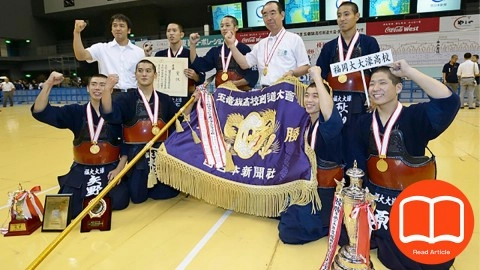Tips for Improving Your Skills through Motivation to Practice
11 30, 2020

Here are some tips for improving your skills through motivation to practice.
Table of Contents
1.How to enjoy practice every day?
Kendo, originated from swordsmanship, has rapidly advanced since the creation of Shinai along with the ways to practice it.
In contrast to competitions that always put you in tense situations, practice requires consistent repetition, which is why motivation is important.
In this chapter, let’s find out various ways to practice Kendo as well as how to motivate yourself.
2.Basics of Practice
The basics of practice are as follows:
Pre-exercise stretching, Suburi (swing), footwork, Kirikaeshi (consecutive strike), various strikes, counter-attack techniques, attack practice, chasing practice, free practice etc.
Besides, there are special practices in accordance with the school’s policy or age group.
The practice method can vary depending on clubs. Adult Kendo clubs tend to focus on basic practices.
Basic Practice
Basic practice is the practice of learning basic movements and techniques. Next is Yakusoku geiko, which is the attacking practice with prearranged roles, a kind of role-playing. When one declares to hit the head, the other accepts.
Uchikomi-geiko
Consecutive strike. If Kenko was mathematics, it's been simple calculation problems so far. Uchikomi geiko is the application problem. It’s a way that superiors use to hit the gaps, and it involves practicing head-hitting and wrist-hitting.
Kakari-geiko
Unilateral strike exercise. Kakari geiko is the advanced version of Uchikomi geiko. You measure your physical strength and skills by continuously striking and getting hit using head-hitting, wrist-hitting, waist-hitting, wrist waist and wrist head. Once you can carry off Kakari geiko, your movement such as footwork will have noticeably improved.
Gokaku-geiko
Neck and neck practice. It’s a practice between players with similar capabilities. It’s similar to rallies in tennis. Although the format is different, it may be more similar to an actual game given that the players freely consult.
Jigeiko
Mutual practice. Jigeiko is named after practicing swordsmanship outdoors on the ground (Ji in Japanese) a long time ago. Some say that it’s named Jigeiko because it’s a practice to build the foundation of Kendo. It also means to present your potential capabilities. Many people call Kokaku geiko Jigeiko, because it is Kokaku geiko that integrates the basics.
3.Three Ways to Motivate Yourself to Practice
Motivation is one way to achieve better performance.
When you have a goal, you will be able to remain calm under any circumstances as you will be confident in a competition or a promotion test. Here are some tips for this.
Set a goal
Consistent practice is the key to increasing your Kendo skills. You need to think about how to keep yourself consistently practicing.
Motivation broadly means “will”, but it refers to what makes you “willed” by definition.
The essential part of motivation is the sense of purpose of why you must practice hard, and what keeps you motivated to practice every day; such as “I want to win the competition” or “I want to get stronger”.
Creating the appropriate atmosphere to practice
If the practice atmosphere is good, you will spontaneously get and remain motivated. Whereas if the atmosphere is not good, you will no longer have the will to practice and be unmotivated.
The content of the practice may differ depending on each player and whether you practice alone or with a colleague, but the basics are all the same.
It would be good to have a practice curriculum in advance so that everyone can enjoy practicing.
Don’t make the practice boring
Repetitive practice is inevitable for improvement, but you will get fed up tired of it.
Prepare the exercises that you can consistently enjoy without getting bored in order to stay motivated.
Pay attention to balanced practice
Although there are many practices, the most important things start from warm-ups to Suburi (swing).
Pre-exercise stretching is not only about stretching your body and getting ready for practice. It will be more effective if you keep in mind that it is a warming up stage to begin practice.
Suburi consists of up and down Suburi, front Suburi, diagonal Suburi, quick Suburi, up and down diagonal Suburi, one-handed Suburi and one-handed quick Suburi, and it is important to practice in a balanced manner.
Try to focus on Suburi and practice each exercise from the bottom of your heart.
Plan the practice you want to focus on
Whether you focus on improving your skills and overcoming hardships, practicing the basics, or practicing counter-attack techniques, it is very effective to decide the practice pattern on your own.
Repetition is the key to improving your skills, therefore it is important to consistently practice, even for a short time.
It is ideal to practice repetitive exercises every day, but you may end up so fed up with the repetitive work.
You may end up losing concentration if you repeat the same exercise over and over, thus you should plan accordingly so that you can practice with a new fresh mind.
Make a change in practice
Once you are fed up with repetitive practice, it may be good to make a change.
For example, let’s make a change in the footwork practice. Generally, what springs to mind is moving back and forth, left and right and diagonally with a Shinai in the center.
Let’s try combining the ladder drill of football with the footwork practice.
It doesn’t have to be an official training ladder. You can utilize a line tape as well.
Introduce game elements
In a school with youths, they sometimes add game elements so that it’s not boring to practice.
The elements include popping a balloon, ball dribbling, rock paper scissors, etc. Please note that you can utilize anything for practice even without professional instruments.
With such elements involved, you will have more joyful practice.
4.Last Words
Although everyone starts Kendo for different reasons, Kendo practice is often associated with a competition full of fierce fighting and spirit.
It is indeed difficult to become what you admire overnight. As a journey of a thousand miles must begin with the first stop, it’s important to advance inch by inch through practice.













